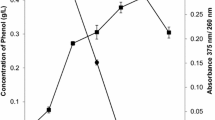Abstract
Recombinant Escherichia coli cells expressing phenol hydroxylase (designated as strain PHIND) were used to synthesize chloro-substituted indigoids by the transformation of indoles. The optimal conditions for the biotransformation of 4- and 7-chloroindole were determined by response surface methodology. Biotransformation kinetic assays revealed that strain PHIND showed high catalytic efficiency for 4- and 7-chloroindole. The formation rate of 7,7′-dichloroindigo (1.35 unit/mg cell dry weight) by strain PHIND was 1.14-fold higher than that of 4,4′-dichloroindigo. The intermediates of 7-chloroindole biotransformation were identified by high-performance liquid chromatography–mass spectroscopy, and the biotransformation mechanism was also proposed. These results suggested that there was a potential application of strain PHIND in the biotransformation of chloro-substituted indoles to valuable indigoids.




Similar content being viewed by others
References
Doukyu, N., Toyoda, K., & Aono, R. (2003). Applied Microbiology and Biotechnology, 60, 720–725.
Hoessel, R., Leclerc, S., Endicott, J. A., Nobel, M. E., Lawrie, A., Tunnah, P., Leost, M., Damiens, E., Marie, D., Marko, D., Niederberger, E., Tang, W., Eisenbrand, G., & Meijer, L. (1999). Nature Cell Biology, 1, 60–67.
Guengerich, F. P., Sorrells, J. L., Schmitt, S., Krauser, J. A., Aryal, P., & Meijer, L. (2004). Journal of Medicinal Chemistry, 47, 3236–3241.
Xiao, Z., Hao, Y., Liu, B., & Qian, L. (2002). Leukemia & Lymphoma, 43, 1763–1768.
Leclerc, S., Garnier, M., Hoessel, R., Marko, D., Bibb, J. A., Snyder, G. L., Greengard, P., Biernat, J., Wu, Y. Z., Mandelkow, E. M., Eisenbrand, G., & Meijer, L. (2001). Journal of Biological Chemistry, 276, 251–260.
Adachi, J., Mori, Y., Matsui, S., Takigami, H., Fujino, J., Kitagawa, H., Miller, C. A., 3rd, Kato, T., Saeki, K., & Matsuda, T. (2001). Journal of Biological Chemistry, 276, 31475–31478.
Ensley, B. D., Ratzkin, B. J., Osslund, T. D., Simon, M. J., Wackett, L. P., & Gibson, D. T. (1983). Science, 222, 167–169.
O'Connor, K. E., & Hartmans, S. (1998). Biotechnology Letters, 20, 219–223.
Drewlo, S., Brämer, C. O., Madkour, M., Mayer, F., & Steinbüchel, A. (2001). Applied and Environmental Microbiology, 67, 1964–1969.
Zhang, Z. G., Liu, Y., Guengerich, F. P., Matse, J. H., Chen, J., & Wu, Z. L. (2009). Journal of Biotechnology, 139, 12–18.
McClay, K., Boss, C., Keresztes, I., & Steffan, R. J. (2005). Applied and Environmental Microbiology, 71, 5476–5483.
Kim, J. Y., Lee, K., Kim, Y., Kim, C. K., & Lee, K. (2003). Letters in Applied Microbiology, 36, 343–348.
Kim, J. Y., Lee, K., Kim, Y., Kim, C. K., & Lee, K. (2005). Letters in Applied Microbiology, 41, 163–168.
Qu, Y. Y., Shi, S. N., Zhou, H., Ma, Q., Li, X. L., Zhang, X. W., & Zhou, J. T. (2012). PLoS One, 7. 10.1371/annotation/087266ef-a19f-4224-a7c2-119d1b363331.
Yun, J. Y., Lee, J. E., Yang, K. M., Cho, S., Kim, A., Kwon, Y. E., & Park, J. B. (2011). Bioprocess and Biosystems Engineering, 35, 211–216.
Mohana, S., Shrivastava, S., Divecha, J., & Madamwar, D. (2008). Bioresource Technology, 99, 562–569.
Han, G. H., Shin, H.-J., & Kim, S. W. (2008). Enzyme and Microbial Technology, 42, 617–623.
Carliell, C. M., Barclay, S. J., Naidoo, N., Buckley, C. A., Mulholland, D. A., & Senior, E. (1995). Water SA, 21, 61–69.
Neujahr, H. Y., & Gaal, A. (1973). European Journal of Biochemistry, 35, 386–400.
Seeger, M., González, M., Cámara, B., Muñoz, L., Ponce, E., Mejías, L., Mascayano, C., Vásquez, Y., & Sepúlveda-Boza, S. (2003). Applied and Environmental Microbiology, 69, 5045–5050.
Wu, Z. L., Podust, L. M., & Guengerich, F. P. (2005). Journal of Biological Chemistry, 280, 41090–41100.
Acknowledgments
This work was supported by the National Creative Research Group from the National Natural Science Foundation of China (no. 51121062), the National Natural Science Foundation of China (nos. 51108120, 51078054, and 51178139), and the 4th Special Financial Grant from the China Postdoctoral Science Foundation (no. 201104430).
Author information
Authors and Affiliations
Corresponding authors
Rights and permissions
About this article
Cite this article
Shi, S., Ma, F., Sun, T. et al. Biotransformation of Chloro-Substituted Indoles to Indigoids by Phenol Hydroxylase from Arthrobacter sp. W1. Appl Biochem Biotechnol 170, 951–961 (2013). https://doi.org/10.1007/s12010-013-0234-y
Received:
Accepted:
Published:
Issue Date:
DOI: https://doi.org/10.1007/s12010-013-0234-y




